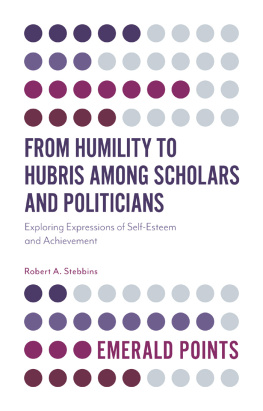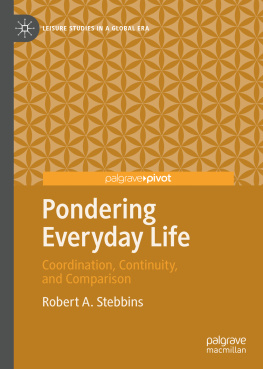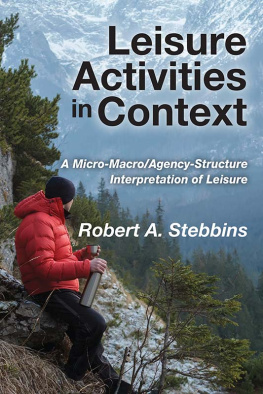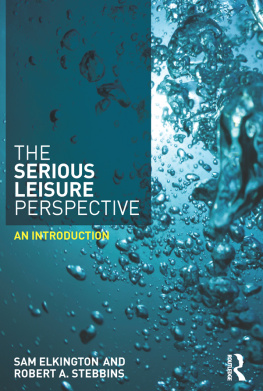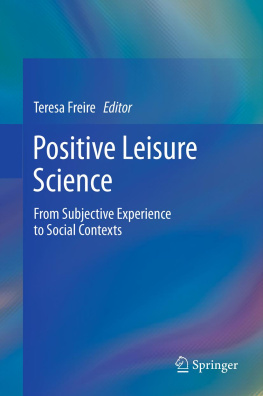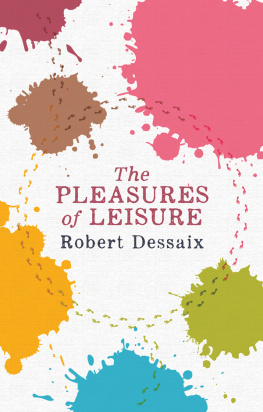LEISURE LIFESTYLES
Organizing Everyday Life for Fun and Fulfillment
BY
ROBERT A. STEBBINS
University of Calgary, Canada
United Kingdom North America Japan India
Malaysia China
Emerald Publishing Limited
Howard House, Wagon Lane, Bingley BD16 1WA, UK
First edition 2021
Copyright 2021 Robert A. Stebbins
Published under Exclusive License by Emerald Publishing Limited
Reprints and permissions service
Contact:
No part of this book may be reproduced, stored in a retrieval system, transmitted in any form or by any means electronic, mechanical, photocopying, recording or otherwise without either the prior written permission of the publisher or a licence permitting restricted copying issued in the UK by The Copyright Licensing Agency and in the USA by The Copyright Clearance Center. Any opinions expressed in the chapters are those of the authors. Whilst Emerald makes every effort to ensure the quality and accuracy of its content, Emerald makes no representation implied or otherwise, as to the chapters' suitability and application and disclaims any warranties, express or implied, to their use.
British Library Cataloguing in Publication Data
A catalogue record for this book is available from the British Library
ISBN: 978-1-80117-601-9 (Print)
ISBN: 978-1-80117-600-2 (Online)
ISBN: 978-1-80117-602-6 (Epub)
Contents
Preface
Lifestyle is one of those commonsense ideas that have been undergoing a parallel scientific elaboration, in this case for over 90 years. In popular usage, lifestyle is a person's or a group's way of life or way of living. Lifestyle is of central concern in the common exhortation of get a life or start living a fuller or more interesting existence. This is a very general conception, however, which squares poorly with the observation that each person's lifestyle is typically unique in its total composition. The challenge facing social science is how to inject some order into this commonsense generality and how to turn it into a useful concept for guiding research while enriching our understanding of what it means. I strive here to meet this test, though only for the domain of leisure.
Learning more about people's lifestyles is worth the effort, be it those of work or leisure, if not the two combined. By doing this, we have learned through research that a person's lifestyle may be more or less agreeable or disagreeable, something to anticipate with eagerness or dread. This evaluation seems to hold more for work lifestyles than for those anchored in leisure, in good part because it is based on different criteria. Thus, work activities may be interesting, involve people fun to be with, and pay decently as well. The same is true about many leisure activities, where there is, however, little or no remuneration. Beyond such broad-gauged criteria lie the distinctive leisure lifestyles, which spring up around particular free-time activities. Examples are legion, including the serious ones of downhill skiing, chamber music playing, amateur archeology, orienteering, tennis, and museum volunteering and the casual ones of regular kaffeeklatsches, sessions of bingo, lunches with colleagues or nonwork friends or relatives, and outings of small walking groups.
Lifestyles in which one or more serious leisure activities figure consist of interests that are regularly pursued. Here, participants must routinely train, practice, rehearse, gather information, and otherwise become steadily involved with the amateur, hobbyist, or career volunteer activity of which they are enamored. The idea of lifestyle does not logically include sporadic involvements in an activity, as happens with some collectors, hikers, tourists (cultural and mass), hobbyist bakers and do-it-yourself enthusiasts, casual players of games and sports, and people who knit.
In addition, leisure lifestyles are structured along the dimensions of time and space and, in the serious pursuits, structured along the lines of the social world in which every lifestyle is embedded. Relationships also shape our leisure lifestyles, covered in this book under the headings of close relationships and acquaintanceships. Finally, lifestyles in general work and leisure together because they are not naturally constituted of harmonious elements, force those who live them to wrestle with how to balance the incompatible elements. Thus, the final pages of this book center on the nature of and quest for an optimal leisure lifestyle. Achieving such harmony in one's working lifestyle is omitted from this discussion based on the belief that the two domains are incomparable. Most work is obligatory, leaving the worker with few opportunities for finding additional positivity there or for redressing its disagreeable aspects as they impact on work or leisure. Not so with leisure itself, however, where much greater freedom exists in which to organize free time that can lead regularly to fun and fulfillment.
All told, this book sets out 10 criteria for examining leisure lifestyles, with the hope that future research thus oriented will provide us with a deep understanding of this important aspect of the modern use of free time. The criteria are solo/collective activities, close relationships, acquaintanceships, casual leisure, serious leisure, certain demographic correlates, time, space, social world, and optimal leisure lifestyle (life balance). The theoretic underpinning of all this is positive psychology (especially the fun, satisfaction, self-fulfillment dimension) and the serious leisure perspective.
Robert A. Stebbins
Calgary, Canada
Acknowledgments
I am grateful to Ramya Murali for her careful attention to the myriad editorial details that must be grappled with in bringing an academic monograph to life. That attention was also efficiently given, keeping us thereby on the inflexible editingprinting schedule that is the hallmark of this industry.
Thanks much,
Bob
1
Leisure Lifestyle Theory and Research
As a concept, lifestyle has many applications, most notably in life in general, in work, and in leisure. In everyday usage, we tend to intermix these three, as we talk about way of life, work/life balance, everyday routine, and similar conceptions. It is evident, too, in the common exhortation of get a life or start living a fuller more interesting existence. The definition of lifestyle guiding this book fits these broad images well:
a distinctive set of patterns of tangible behavior that is organized around a set of coherent interests or social conditions or both, that is explained and justified by a set of related values, attitudes, and orientations and that, under certain conditions, becomes the basis for a separate, common social identity for its participants.
(Developed from Sobel, 1981; Veal, 1993; and Stebbins, 1997a)
Daria Miseng (2019, p. 236) summarizes these earlier conceptualizations as
a characteristic of an individual's life activity that manifests itself in regular behavior patterns at various levels of this activity, namely: (1) an individual's general interaction with the world, (2) life strategies and tactics, and (3) cultural preferences. Describing lifestyle as a characteristic of life activity and a product of an individual's interaction with the environment, it is necessary to consider it as a manifestation of subjectivity and individuality, which can reflect personal life choices and self-actualization prospects in the form of a certain social quality in a specific context of relations with the world.





